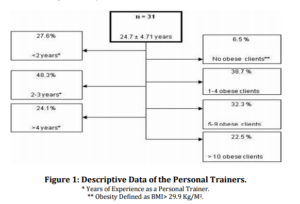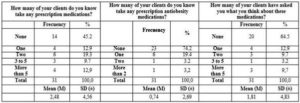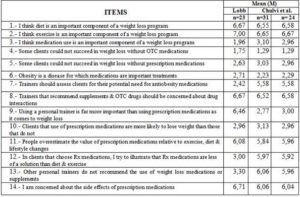Introduction
Obesity (as a disease) and its risk of co-morbidities and mortality have reached epidemic levels, (Heredia et al., 2008; Villareal et al., 2005; Flegal et al., 2005; Dishman et al., 2004). Also an excess of body fat and body weight are associated with a decrease in physical fitness in young (Nikolaidis 2012a,b), adolescent, adult (Nikolaidis and Ingebrigtsen, 2013), and elderly (Villareal et al., 2005; Stewart et al., 2003) people. In Spain, 14.5% of the total population is considered obese (Aranceta et al., 2008). The behavioural changes necessary to battle obesity are multifaceted (Heredia et al., 2008), and given that exercise (lifestyle medication) is an important way to control body weight and dietary interventions (e.g. very low calorie and low fat diets) (Van Baak, 2013; Donelly et al., 2009; Stiegler and Cunliffe, 2006). Physical exercise recommendations are based on the dose-response relationship (Donelly et al., 2009; Rubio et al., 2007) and it’s an important factor for weight control and avoid regain the weight lost (Jakicic, 2003). Thus, physical exercise in these cases should be designed, planned and supervised by a specialist. In this sense, personal trainers are important partners in the battle against obesity. Certificated personal trainer is a professional that instructs and trains persons in terms of safe and efficient exercises usually in individual conditions for increasing their physical fitness/performance and health (Roberts et al., 1997).
Personal trainers are recognized as having a high level of expertise in exercise prescription, athletics, sports, and health (Chulvi et al., 2007), as well as the specific topic of obesity (Chulvi et al., 2008), this professional profile has been developed extensively in the United States, being a growing movement in Spain. It has been reported that personal trainers can be effective in emphasizing the importance of improving one’s body image and engaging in a healthy level of physical activity; both of which can lead to the client´s expected bodily response and adaptation (Ratamess et al., 2008). Additionally, a personal trainer can exert great influence for instance, McClaran et al., (2003) demonstrated that the use of a personal trainer once per week improves adherence to and attitudes towards exercise. A previous report has shown a correlation between related factors (such as processes of change, decisional balance, and scheduling self-efficacy) to activity behaviour in female students that are utilizing personal trainers (Fischer et al., 2008).
A variable of great importance in the fight against weight gain and obesity in general is adherence to an exercise program. It is understood that people have difficulty with maintaining an active lifestyle (Knuth et al., 2009), and making time for physical activity is the most commonly reported barrier to being active among all population (Jakicic et al., 2003). The use of physical activity, nutrition and prescription medication can be an effective solution when exercise is not enough or is not utilized by the individual, (Ioannides et al., 2011; Rubio et al., 2007; Bellido et al., 2006).
However, there appears to be a need to increase awareness of anti-obesity medications in personal trainers (Lobb et al., 2008). In Spain there are two primary drugs prescribed for obesity, orlistat and sibutramine (Rubio et al., 2007; Bellido et al., 2006). The use of these drugs is suggested for people with a body mass index (BMI) between 29.9 and 37 who do not achieve appropriate results with the use of nutritional and behavioural therapies including physical activity (Rubio et al., 2007). As drugs may be an integral part of treatment in some cases of obesity, it is important to understand the perceptions that personal trainers have about these drugs because their advice can have a direct influence on the client´s behaviour.
The aim of this study was to determine and to compare the perceptions of Spanish personal trainers regarding medications for the treatment of obesity with American personal trainers include in the research of Lobb et al., (2008).
Methods
Personal trainers can have great importance in the conducts and behaviours of obese individuals. In this sense, we have evaluated the perception of drugs and supplements for weight loss in Spanish personal trainers that are currently certified. Our hypothesis was the Spanish personal trainers have a bad perception of anti-obesity drugs. We have translated the questionnaire used previously by Lobb et al., (2008) and it has been administered via Internet to Spanish personal trainers. These personal trainers should be knowledgeable about medications for weight loss or personal training experience with subjects under pharmacological treatment.
Subjects
31 personal trainers certified by various national or international private academies participated in the study. The criterion for inclusion was currently working as a personal trainer, holding a valid certification as designated by NSCA (National Strength and Conditioning Association), ACSM (American College of Sports Medicine), ANEF, FEDA and ORTHOS. The age of the respondents ranged between 18 and 35 years, with an average age (M) of 24.7 years and a standard deviation (SD) of 4.74. 27.6% of the interviewees had two years of experience or less as a personal trainer, and 48.3% of the trainers had between two and three years of experience. The remaining 24.1% of the sample had four or more years of experience. Additionally, 6.5% of the respondents had no clients with a BMI greater than 30 kg/m2 (obese), 38.7% had 1 to 4 obese clients, and 32.3% of the sample had 5 to 9 obese clients. Finally, the remaining 22.5% of the sample had more than 10 obese clients (see Figure 1).

Procedure
The subjects were recruited by e-mail to participate in the study. The questionnaires were completed by certified personal trainers. During the process of filling out the questionnaire, one of the authors of the study was available online to answer questions for clarification purposes. Participation was voluntary and the respondents had to show proof that they were certified by one of the various associations of personal trainers.
Questionnaire
A translation of a questionnaire developed by Lobb et al., (2008) was utilized in the current study. The instrument consisted of 18 items assessing perceptions on a 7-item Likert-type scale ranging from strongly disagree [1] to strongly agree [7]. The survey also contained questions regarding age, years of experience as a personal trainer, the number of clients classified as obese, and questions related to knowledge about over-the-counter (OTC) and prescription anti-obesity medications.
Statistical Analysis
The results were analysed using the statistical package SPSS (Version 15). A standard statistical methods for obtaining the frequency were used to obtain the mean as a measurement of the central trend and standard deviation as a measurement of dispersion.
Results
The results are reported in three sections. The first section addresses the medicine-taking behaviour of the clients as reported by the personal trainers. The second section addresses the knowledge of the personal trainers about OTC and prescription anti-obesity medications. The third section addresses the perceptions measured on the Likert-type scale, and compares the data to those reported in the previous study14, which used an American sample.
1. Client Obesity and Drug Treatment
Table 1 shows that each personal trainer had an average of 2.48 clients who reportedly were on prescription medications of any kind. 45.2% of the personal trainers did not have any client currently taking medications of any type. Approximately 75% of the personal trainers did not have clients taking prescription anti-obesity medications. Finally, the third section of the table shows that, on average, each personal trainer had 1.81 clients who had requested the trainer’s opinion of anti-obesity medications. 64.5% of the trainers had not been asked about obesity fighting medications/supplements by their clients.
Table 1: Clients Obesity and Drug Treatment 2.

2. Knowledge of Anti-obesity Medications
12.9% of the personal trainers were unaware of any OTC weight loss supplements (see Table 2). The remaining 87,1% knew of at least one product. One in four respondents knew of two products (25.8%), and 6.5% knew of three.
Regarding knowledge of prescription weight loss medications (see table 2), 22.6% did not know of any medications for the treatment of obesity. 51.6% knew of one medication while the remaining 25.8% knew of two medications. In total, 74.2% of the trainers were familiar with prescription weight loss medications.
Table 2: Personal Trainer Awareness of Weight Loss Medications

3. Perceptions Regarding the Procedures for Weight Loss
In Table 3 we present the average response obtained for each item on the battery. The first column shows the results obtained by Lobb et al., (2008) which will be referred to as Lobb’s Group (LG) (n=23). The second column shows the results of the entire sample of the present study (n = 31) which will be referred to as the total group (TG). Finally, the last column shows the results for the subset of trainers who knew of at least one weight loss medication (n = 24), similar to the procedure used by Lobb et al.,14 will be referred to as the knowledge group (KG).
Table 3: Perceptions Regarding the Procedures for Weight Loss

Discussion
The primary objective of our study was to compare the perceptions regarding weight loss medications among a sample of Spanish personal trainers with those obtained by Lobb et al., (2008). Thus, the discussion is based on a comparison of the current study and the American study.
The initial sample in the previous report was comprised of 43 personal trainers. The perceptions were obtained from a subsample of 23 participants. The criterion for inclusion in the subsample was to have some knowledge about anti-obesity drugs. In our case, from the total sample of 31 participants, 24 met this criterion. This number of subjects is not high thus represented a powerful study limitation, additionally, questionnaire were not conducted at random due to insufficient sample.
The personal trainers surveyed attributed great importance to diet and exercise as components of weight-reduction programs. These results match those of Lobb et al., (2008). In both studies, personal trainers did not give undue weight to medication in the successful treatment of obesity.
Regarding physical exercise and diet as weight-loss methods, the data from Lobb’s survey had a different trend (M = 3.00). That is, in our study, personal trainers informed their clients that anti-obesity drugs are less important than physical exercise and diet for reducing weight. In other words, they trivialized the importance of drugs. Trainers surveyed by Lobb et al., (2008) tended not to do so.
Answers to items related to the importance of personal trainers in achieving weight loss indicate that trainers from neither sample emphasized medication as a component of a weight-reduction program.
Personal trainers believed that clients and people in general, tend to rate medicine as more important than a personal trainer in reducing body weight. In both studies, trainers believed that people in general, and their clients in particular, overestimate the effectiveness of anti-obesity drugs.
Personal trainers surveyed by Lobb et al., (2008), believed that weight loss is achieved better with a personal trainer than prescription medication. The Spanish personal trainers did not grant themselves as much importance in the treatment of obesity. This could be related to the fact that personal training is a relatively new concept in Spain, or perhaps that the educational programs conducted by private institutions in Spain do not adequately train their students.
The personal trainers of our study agreed that they are capable of assessing the need of the clients for drug treatment. American trainers were more likely to disagree with this point, Lobb et al., (2008). This disagreement could be due to stronger restrictions among American personal trainers when dealing with medical issues in their clients.
The personal trainers from both studies believed that the consumption of drugs and supplements have side effects and, as personal trainers, were generally opposed to such consumption. In both studies respondents were aware of the need to receive more training on issues like obesity, drug treatments, and their interaction with exercise (Lobb et al., 2008).
The current data show that among personal trainers, there is a tendency to place a great deal of emphasis on exercise and diet, leaving the use of anti-obesity drugs as a last resort. According to McClaran et al., (2003), this may facilitate the promotion of healthy lifestyles including physical activity and healthy nutrition.
For the last item the average score obtained represents the desire to know more about anti-obesity drugs and interactions with the physical exercise, this data is very similar that reported by Lobb et al., (2008), and shown the growing interest for increasing the number of qualities and competencies that an effective exercise leader will be required, Melton et al., (2010).
The most obvious limitation of the study is its small number of participant in this study, thus, the number of cases is too limited for broad generalizations and the conclusions must be interpreted with caution.
In conclusion, the perception of trainers is that clients overestimate the effectiveness of anti-obesity drugs. Personal trainers believe that drugs and supplements have side effects. They also believe that they need more training regarding obesity, drug treatments, and their interaction with exercise. Personal trainers are aware of their role in fighting obesity, therefore institutions and training academies should require more specific training on this topic. Personal trainers can play a very important role in the weight loss process by creating personalized exercise regimens. Specific education for personal trainers should include the importance of physical exercise, dietary recommendations, and medical options for weight loss, as well as when such options are advisable, how they work, and the possible negative side effects.
References
Aranceta, J., Pérez, C., Serra, L. L., Ribas, L., Quiles, J., Vioque, J., Tur, J., Mataix J, Llopis, J., Tojo, R., Foz, M. & Collaborative Group for the Study of Obesity in Spain (2003). “Prevalence of Obesity in Spain: Study of the Results SEEDO 2000 Study,” Medicina Clinica,120(16):608-12.
Publisher
Bellido, D. (2006). ‘The Overweight Patient: A Practical Guide for Action in Primary Care,’ Revista Espa-ola de Obesidad, 4(1):33-44.
Chulvi, I., Heredia, J. R., Isidro, F. & Masiá, L. (2008). “The Personal Trainer and Obesity,” Portaldeportivo.Cl [Internet] Nº6 Mayo-Junio Available http://www.culturafitness.com/documents/entrenador_personal_y_obesidad.pdf
Publisher
Chulvi-Medrano, I., Pomar-Puig, R., Heredia-Elvar, J. R. & Colado, J. C. (2007). “Personalized Physical Training in Improving Health and Athletic Performance,” www.efdeportes.com [internet] 12 (112) availablehttp://www.efdeportes.com/efd112/el-entrenamiento-fisico-personalizado.htm.
Publisher
Dishman, R. K., Washburn, R. A & Heath, G. W. (2004). Physical Activity Epidemiology, Human Kinetics Champaign, Illionois, USA.
Publisher – Google Scholar
Donnelly, J. E., Blair, S. N., Jakicic, J. M., Manore, M. M., Rankin, J. W. & Smith, B. K. (2009). “Appropriate Physical Activity Intervention Strategies for Weight Loss and Prevention of Weigth Regain for Adults,” Medicine and Science in Sports and Exercise, 41(2):459-71.
Publisher – Google Scholar
Fischer, D. V. & Bryan, J. (2008). “Effect of Certified Personal Trainer Services on Stage of Exercise Behaviour and Exercise Mediators in Female College Students,” Journal of American College Health, 56(4): 369-76.
Publisher – Google Scholar
Flegal, K. M, Graubard, B. L., Williams, D. F. & Gail, M. H. (2005). “Excess Deaths Associated with Underweight, Overweight, and Obesity,” JAMA, 293(15):1861-7.
Publisher – Google Scholar
Heredia, J. R., Isidro, F., Roig, J. L., Chulvi, I., Moral, S. & Molins, A. (2008). ‘Overweight / Obesity, Physical Activity and Health: Intervention through Fitness Programs,’ Wanceulen, Sevilla, Espa-a.
Ioannides-Demos, L. L., Picenna, L. & Mcneil, J. J. (2011). “Pharmacotherapies for Obesity: Past, Current, and Future Therapies,” Journal of Obesity, 2011:179674.
Publisher – Google Scholar
Jakicic, J. M. (2003). “Exercise in the Treatment of Obesity,” Endocrinology and Metabolism Clinics of North America,32(4):967-980.
Publisher – Google Scholar
Jakicic, J. M. & Gallagher, K. I. (2003). “Exercise Considerations for the Sedentary Overweight Adult,” Exercise and Sport Science Reviews, 31(2):91-5.
Publisher – Google Scholar
Knuth, A. G. & Hallal, P. C. (2009). “Temporal Trends in Physical Activity: A Systematic Review,” Journal of Physical Activity and Health, 6(5):548-59.
Publisher – Google Scholar
Lobb, L. R., Lobb, W. B. & Hallam, J. S. (2008). “Perceptions of Antiobesity Medications among Personal Trainers,”Journal of Strength and Conditioning Research, 22(2):485-489.
Publisher – Google Scholar
McClaran, S. R. (2003). “The Effectiveness of Personal Training on Changing Attitudes towards Physical Activity,”Journal of Sports Science and Medicine, 2:10-4.
Publisher – Google Scholar
Melton, D. I., Dail, T. K., Katula, J. A. & Mustian, K. M. (2010). “The Current State of Personal Training: Managers’ Perspectives,” Journal of Strength and Conditioning Research, 24 (11):3173-3179.
Publisher – Google Scholar
Nikolaidis, P. T. (2012). “Association between Body Mass Index and Body Fat Per Cent are associated with Decreased Power Output in Soccer Players,” Central European Journal of Medicine, 7(6):783-9.
Publisher – Google Scholar
Nikolaidis, P. T. (2012). “Physical Fitness Is Inversely Related with Body Mass Index and Body Fat Percentage in Soccer Players Aged 16-18 Years,” Medical Review (Medicinski Pregled), 65(11-12):470-475.
Publisher – Google Scholar
Nikolaidis, P. T. (2013). “Body Mass Index and Body Fat Percentage are associated with Decreased Physical Fitness in Adolescent and Adult Female Volleyball Players,” Journal of Research in Medical Sciences, 18(1):22-6.
Publisher – Google Scholar
Nikolaidis, P. T. & Ingebrigtsen, J. (2013). ‘The Effect of Excess Body Mass on Physical Fitness in Adolescent and Adult Male Handball Players,’ Indian Journal of Physiology and Pharmacology, 57(4).
Ratamess, N. A., Faigenbaum, A. D., Hoffman, J. R. & Kang, J. (2008). “Self-Selected Resistance Training Intensity in Healthy Women: The Influence of a Personal Trainer,” Journal of Strength and Conditioning Research, 22(1):103-11.
Publisher – Google Scholar
Roberts, S. (1997). ‘The Business of Personal Training,’ Human Kinentics, Champaing, Ilionois, USA.
Rubio, M. A., Salas-Salvadó, J. & Barbany, M. (2007). ‘Consensus SEEDO 2007 for the Assessment of Overweight and Obesity and the Establishment of Criteria for Therapeutic Intervention,’ Revista Espa-ola de Obesidad, 7-48.
Stewart, K. J., Turner, K. L., Bacher, A. C., Deregis, J. R., Sung, J., Tayback, M. & Ouyang, P. (2003). “Are Fitness, Activity, and Fatness associated with Health-Related Quality of Life and Mood in Older Persons?,” Journal of Cardiopulmonar Rehabilitation, 23 (2): 115-121.
Publisher – Google Scholar
Stiegler, P. & Cunliffe, A. (2006). “The Role of Diet and Exercise for the Maintenance of Fat-Free Mass and Resting Metabolic Rate During Weigth Loss,” Sports Medicine, 2006; 36 (3): 239-262.
Publisher – Google Scholar
Van Baak, M. A. (2013). “Nutrition as a Link Between Obesity and Cardiovascular Disease: How Can We Stop the Obesity Epidemic?,” Thrombosis and Haemostasia.
Publisher – Google Scholar
Villareal, D. T., Apovian, C. M., Kushner, R. & Klein, S. (2005). “Obesity in Older Adults: Technical Review and Position Statement of the American Society for Nutrition and NAASO the Obesity Society,” Obesity Research 2005; 13: 1849-1863.
Publisher – Google Scholar







